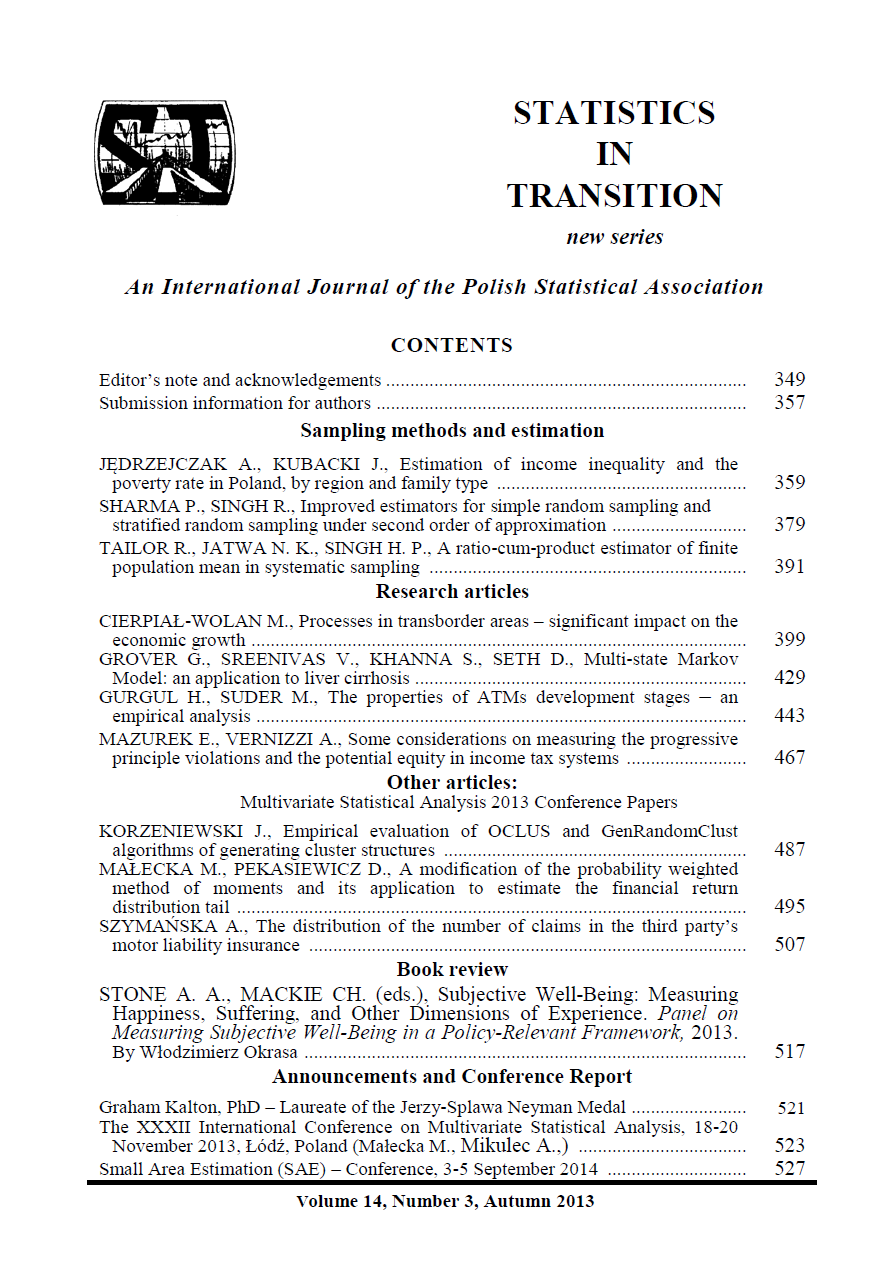ARTICLE
ABSTRACT
This paper addresses the crucial problem of the ATM’s network management which is so-called the saturation level of withdrawals. This notion refers to mean level of withdrawals after dropping particular withdrawals realized in the initial time period, (i.e. time period after activation of ATM) and the length of elapsing time period necessary to reach saturation level. One can observe that the level of withdrawals and their number stabilize as time elapses. The paper aims to define average withdrawals after achieving saturation level and mean time necessary to stabilize withdrawals (based on historical data). In addition, we established that – under condition of similarity in terms of location and date of start - ATMs exhibit similar characteristics of the development effects. This allows us for predicting the size of time necessary to achieve saturation and the average withdrawal in the state of saturation.
KEYWORDS
ATM, withdrawals, saturation level
JEL
C49, C53
REFERENCES
AMROMIN, E., CHAKRAVORTI, S., (2007). Debit card and cash usage: a cross-country analysis. Technical report. Federal Reserve Bank of Chicago.
BOESCHOTEN, W. C., (1998). Cash management, payment patterns and the demand for money. De Economist, 146, 117–42.
BRENTNALL, A. R., CROWDER, M. J., HAND, D. J., (2008). A statistical model for the temporal pattern of individual automated teller machine withdrawals, Appl. Statist., 57, Part 1, 43–59.
BRENTNALL, A. R., CROWDER, M. J., HAND, D. J., (2010). Predicting the amount individuals withdraw at cash machines using a random effects multinomial model. Statistical Modelling, 10(2), 197–214.
CARLSEN, M., STORGAARD, P. E., (2010). Dankort payments as a timely indicator of retail sales in Denmark. Danmarks Nationalbank Working Papers, No. 66.
CLARKE, R., DAVIS, S., WATERSON, M., (1984). The profitability concentration relation: market power or efficiency. The Journal of Industrial Economics, 32, 435–50.
CLEVELAND, W. S., DEVLIN, S. J., (1980). Calendar Effects in Monthly Time Series: Detection by Spectrum Analysis and Graphical Methods. Journal of the American Statistical Association, 75, 487–496.
ESTEVES, P. S., (2009). Are ATM/POS Data Relevant When Now casting Private Consumption? Banco de Portugal Working Paper, 25.
EVANOFF, D., FORTIER, L., (1988). Re-evaluation of the structure-conduct performance paradigm in banking. Journal of Financial Service Research, 1, 277–94.
FINDLEY, D. F., MONSELL, B. C., (2009). Modeling Stock Trading Day Ef fects Under Flow Day-of-Week Effect Constraints. Journal of Official Statistics, 25(3), 415–430.
FINDLEY, D. F., MONSELL, B. C., BELL, W. R., OTTO, M. C., CHEN, B. C., (1998). New capabilities and Methods of the X-12-ARIMA seasonal adjustment program. Journal of Business and Economic Statistics, 16(2), 127–77.
FINDLEY, D. F., SOUKUP, R. J., (1999). On the Spectrum Diagnostics Used by X-12-ARIMA to Indicate the Presence of Trading Day Effects after Modeling or Adjustment. Proceedings of the American Statistical Association. Business and Statistics Section, 144–49.
FINDLEY, D. F., SOUKUP, R. J., (2000). Modeling and Model Selection for Moving Holidays. Proceedings of the American Statistical Association. Business and Economics Statistics Section, 102–07.
FINDLEY, D. F., SOUKUP, R. J., (2001). Detection and Modeling of Trading Day Effects. in ICES II: Proceedings of the Second International Conference on Economic Surveys, 743–53.
GALBRAITH, J. W., TKACZ, G., (2007). Electronic Transactions as High Frequency Indicators of Economic Activity. Bank of Canada Working Paper, 58.
GURGUL, G., SUDER, M., (2012). Efekt kalendarza wypłat z bankomatów sieci Euronet, WSEI Research Journal, 8, 25–42.
HAND, D. J., BLUNT G., (2001). Prospecting for gems in credit card data. IMA Journal of Management Mathematics, 12, 173–200.
HOLDEN, K., EL-BANNANY, M., (2004). Investment in information technology systems and other determinants of bank profitability in the UK. Applied Financial Economics, 14, 361–5.
KONDO, K., (2003). How useful are ATMs for Japanese banks in the latter 1990s?, Review of Monetary and Financial Studies, 19, 43-54 (in Japanese).
KONDO, K., (2010). Do ATMs influence bank profitability in Japan? Applied Economics Letters, 17, 297–303.
KUFEL, T., (2010). Ekonometryczna analiza cykliczności procesów gospodarczych o wysokiej częstotliwości obserwowania, The Nicolaus Copernicus University Scientific Publishing House, Toruń.
LIU, L. M., (1980). Analysis of Time Series with Calendar Effects. Management Science, 26, 106–112.
LLOYD-WILLIAMS, D. M., MOLYNEUX, P., (1994). Market structure and performance in Spanish banking. Journal of Banking and Finance, 18, 433–43.
MCELROY, T. S., HOLLAND, S., (2005). A Nonparametric Test for Assessing Spectral Peaks. Research Report 2005-10. Statistical Research Division. U.S. Bureau of the Census, Washington D. C.
MOLYNEUX, P., FORBES, W., (1995). Market structure and performance in European banking. Applied Economics, 27, 155–9.
NACEUR, S. B., GOAIED, M., (2001). The determinants of the Tunisian deposit banks’ performance. Applied Financial Economics, 11, 317–9.
RHOADES, S. A., RUTZ, R. D., (1982). Market power and firm risk: a test of the ‘Quiet Life’ hypothesis. Journal of Monetary Economics, 9, 73–85.
SIMUTIS, R., DILIJONAS, D., BASTINA, L., (2008). Cash demand forecasting for ATM using Neural Networks and support vector regression algorithms. 20th International Conference. EURO Mini Conference. “Continuous Optimization and Knowledge-Based Technologies” (EurOPT- 2008). Selected Papers. Vilnius May 20–23, 416–421.
SMIRLOCK, M., (1985). Evidence on the (non) relationship between concentration and profitability in banking. Journal of Money, Credit and Banking, 17, 69.
SNELLMAN, H., VIREN, M., (2009). ATM networks and cash usage. Applied Financial Economics, 19 (10), 841–851
